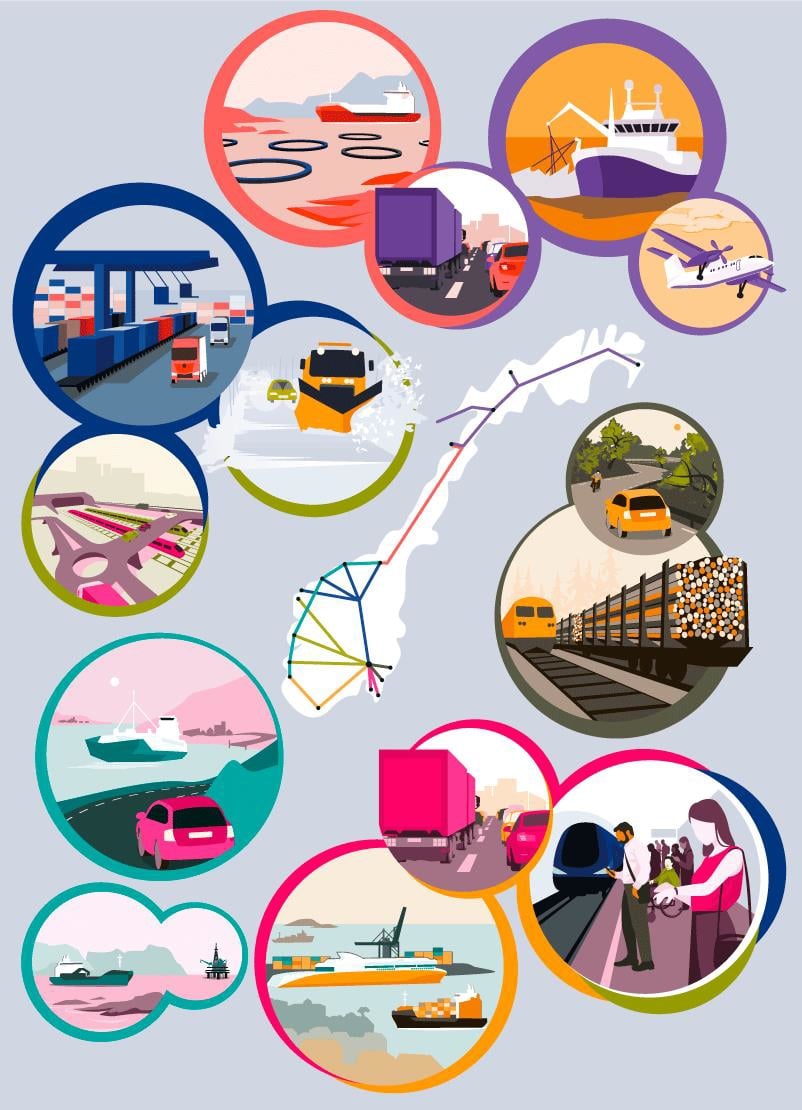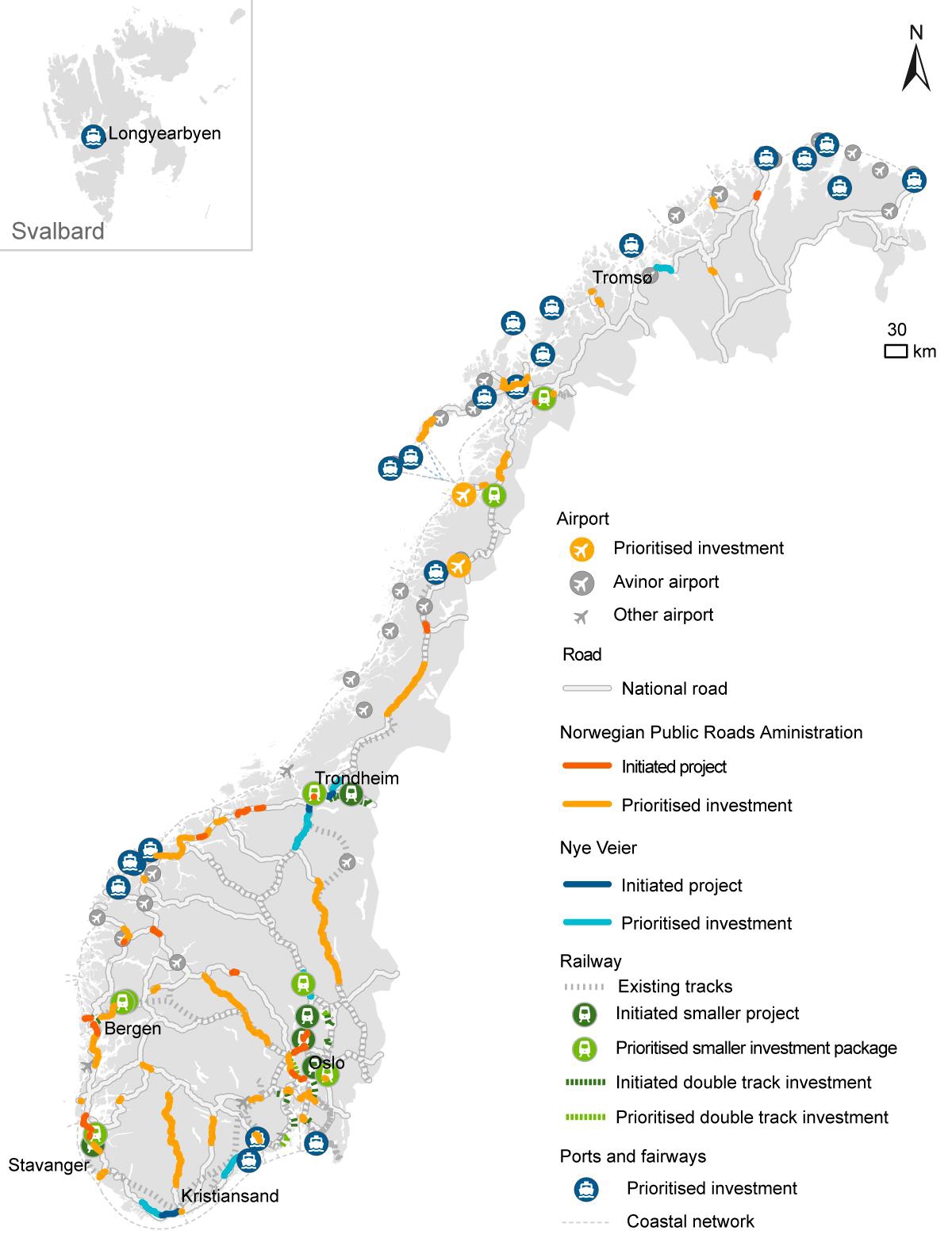7 Selected important projects and measures
Maintenance and renewal efforts will be strengthened. Around a quarter of the state’s budgetary spending will be spent on operation, maintenance and renewal. The Government gives high priority to preserving the existing infrastructure, and to facilitating operation of the infrastructure to achieve efficient transport.
The Government will develop the national road network in all of Norway. Around 40 landslide/rockslide-, improvement- and development-projects are planned for all over Norway. Some of these are described in Chapter 7.1. below. At the same time, the projects that have already been initiated, such as E18 Lysaker–Ramstadsletta, E39 Rogfast, Rv. 555 Sotrasambandet (Sotra Connection), E39 Lønset–Hjelset, E39 Betna–Vinjeøra–Stormyra, E16 Bjørum–Skaret, Rv. 4 Roa–Gran and E6 Helgeland South, will tie up a large portion of the budget in the years ahead.
Nye Veier’s budgetary framework by annual grants has been extended from 2035 to 2041. This will enable the company to expand its portfolio from 700 to 1,226 km of national roads, and to cover a larger geographical area.
The Government has prioritised increasing grants to the county authorities to expand housing and labour market regions, to improve conditions for commercial traffic and to upgrade tunnels. A continued strong focus on Urban Growth Agreements and co-funding of large scale public transport projects in the major urban areas are also prioritised.
In the rail sector, the Government will prioritise increased maintenance and renewal, and ensuring that already initiated railway investment packages are completed. This means giving priority to InterCity rail infrastructure to Hamar, Tønsberg and Moss. Plans have been made to initiate eleven new investment packages, which will improve both passenger and freight transport services. The investment packages will enable increased the frequency to and from Trondheim, Oslo, Bergen and Stavanger, and improve WiFi coverage. The Ringerike Line, the Arna–Stanghelle section of the Voss Line and the Stokke–Sandefjord section of the outer InterCity Vestfold Line are prioritised large scale projects in the initial six-year period.
The Stad Ship Tunnel is prioritised in the initial six-year period. The Government also plans to make more funds available for fairway improvements and reducing the maintenance backlog on aids to navigation along the coast. The grant scheme for short sea shipping (incentive scheme) is continued, while there are plans to strengthen the grant scheme for efficient and environmental-friendly ports.
The Government has prioritised the implementation of pilot projects for fossil-free construction sites, and dedicated grant funding for the Children’s Transport Plan. The Government will strengthen its focus on research and piloting in the transport field and will also facilitate better use of data in the transport sector.

Figure 7.1 Transport corridors – different challenges and priorities
7.1 Ambitions for developing the transport corridors during the plan period
The eight national transport corridors comprise the most important long-distance transport routes in Norway and play a key role in the competitiveness of Norwegian business and industry. By developing the national transport corridors, the Government will also contribute to developing the housing and labour market regions all over Norway.
Oslo–Svinesund/Kornsjø (Corridor 1)
In the initial six-year period, the plan will facilitate completion of the ongoing extensive rail investments in the Østfold Line. At the same time, accessibility will be improved on the road network, including the development of Rv. 22 Glommakryssing (crossing of the Glomma river), and measures will be implemented to improve safety and accessibility for sea transport. Further possible development of the rail sector is planned for the second six-year period. This will improve the train service to the towns in the south of Viken county, and strengthen international connections for freight and passenger transport. Furthermore, road projects will be explored to increase accessibility and traffic safety in and around cities and towns, while new surveys and assessments will form the basis for the development of fairway projects.
Oslo–Ørje/Magnor (Corridor 2)
In the initial six-year period, the focus will be on improving accessibility on the road network from the Swedish border and towards Oslo through the development of E18 Retvet–Vinterbro. Nye Veier will consider the project E16 Kongsvinger–E6. Measures will also be prioritised in the initial six-year period that increase capacity for freight transport by rail. In the second six-year period, strategies will be developed for further improvement and development of the road network, and for facilitating further development of the Kongsvinger Line.
Oslo–Grenland–Kristiansand–Stavanger (Corridor 3)
In the initial six-year period, the plan will facilitate completion of investments in the Vestfold Line, to enable four train departures per hour between Tønsberg and Oslo. By prioritising the start-up of the outer InterCity investment package on the Vestfold Line, the Government also wants to improve the train service between Oslo and Skien. This will enable two trains per hour on this section. Smaller projects on the Jæren Line will also be prioritised. The Government plans considerable investments in the road sector, and will prioritise the start-up of several major projects, including on Rv. 19 Moss, E39 Ålgård–Hove, E134 Oslofjord connection (stage 2), E134 Dagslett–E18 and E18/E39 Gartnerløkka–Kolsdalen. Nye Veier is responsible for important road stretches in this corridor, and will consider implementing measures here. Accessibility and safety measures along the coast will also be given priority.
During the second six-year period, solutions may be considered for the rail sector that will strengthen the growing housing and labour markets in Nord-Jæren and Buskerudbyen in the long-term. Strategies will also be developed for further improvement and development of the road network, and new fairway initiatives will be considered.
E18 Lysaker–Ramstadsletta in Bærum was started in November 2020. This is the first phase of the planned development of E18 between Lysaker and Drengsrud in Viken (West Corridor). This phase also includes the cross connection between Gjønnes and Fornebu. Further planning of E18 West Corridor is under way.
Stavanger–Bergen–Ålesund–Trondheim (Corridor 4)
In the initial six-year period, the Government plans significant spending on completing several large scale road projects in the corridor, including Rogfast and the Sotra Connection (a Public-Private Partnership). The fjord crossing projects E39 Ådland–Svegatjørn and E39 Ålesund-Molde, which will contribute to a significant reduction in travel times in this corridor, will also be prioritised. It is proposed to transfer several landslide/rockslide protection projects on Rv. 13 to the portifolio of Nye Veier. Building the Stad Ship Tunnel will improve accessibility and contribute to increased safety. In the second six-year period, landslide/rockslide protection and improvements to the road network are planned in order to increase accessibility and traffic safety. Fjord crossings and improvements to the various roads between the fjords in and around the urban areas will be weighed against each other. New surveys and assessments will form the basis for the development of fairway projects.
Oslo–Bergen/Haugesund (Corridor 5)
Resources spent in this corridor will improve the quality of the road network and secure stretches of road that are susceptible to landslides/rockslides. Investments here will also improve the railway services and increase capacity. In the initial six-year period, the Government will prioritise the joint project Ringerike Line (railway) and E16 Høgkastet–Hønefoss (highway). Nye Veier’s portfolio will be expanded to include the E16 Skaret–Høgkastet section. These projects will result in one continuous housing and labour market region from Oslo to Ringerike. In the western part of the corridor, the Government will prioritise the development of the road and railway between Arna and Stanghelle, which will increase traffic safety and capacity. The Government also plans to complete the building of a double track between Arna and Bergen, in addition to several road projects, including Rv. 36 Skjelsvik–Skyggestein and E134 Røldal–Seljestad. In the second six-year period, work will continue on developing better accessibility on roads and railways in the corridor.
Oslo–Trondheim, with branches to Måløy, Ålesund and Kristiansund (Corridor 6)
In the initial six-year period, investments in the Dovre Line will facilitate more and quicker train departures between Hamar and Oslo. Measures are also planned for combined freight transport by rail, in addition to road projects on Rv. 3 in Østerdalen and on E136 in Ålesund. Nye Veier is responsible for a relatively large share of the proposed road projects in this corridor, and will consider the stretches for which they are responsible. In the last six-year period, strategies will be developed for further improvement and development of the road network, and new railway projects will be developed.
Trondheim–Bodø, with branches to the Swedish border (Corridor 7)
In the initial six-year period, investments in the Trønder and Meråker Lines will facilitate the possibility for two trains per hour between Melhus and Steinkjer and also electrified rail travel between Trondheim-Stjørdal, Stavne-Leangen and the Meråker line. The Government is also planning measures for combined freight transport by rail between Trondheim and Bodø. Plans will be made for major improvements of sections of the E6 road north from Grong in Trøndelag county to Nordland county. Nye Veier is responsible for a relatively large share of the proposed road projects in this corridor, and will consider measures for the stretches for which they are responsible. Nye Veier’s portfolio will be expanded to more stretches of road in this corridor. To improve conditions for sea transport, there are plans to improve the fairway to Mo i Rana. The Government also plans to allocate funding for the relocation of Bodø Airport, which will release land for urban development. Grants for a new airport in Mo i Rana are also prioritised, which will enable a more expedient approach and allow larger aircraft to land and take off. New road and rail projects will be developed in the second six-year period. Regional development and efficient rail freight transport will be emphasised. New surveys and assessments will form the basis for the development of fairway projects.
Bodø–Narvik–Tromsø–Kirkenes (Corridor 8)
The investments in the initial six-year period gives room for starting up more road projects, such as Hålogalandsveien (a Public- Private Partnership) and E6 Megården–Mørsvikbotn. Nye Veier will consider the stretches of road for which it is responsible, and its portfolio will be expanded in this corridor. The Government plans to implement several measures in the coastal area that will improve safety and accessibility for sea transport and access to several ports in the corridor. New port facilities are still needed in Longyearbyen, but circumstances have changed since Report No 33 to the Storting (2016–2017) National Transport Plan 2018–2029 was submitted. Upgrades for the Ofoten Line are included in the package for combined freight transport between Oslo and Narvik.
In the last six-year period, the plan is to further improve the road network and better protect against landslides/rockslides in the corridor. Studies of further capacity needs on the Ofoten Line will form the basis for assessing new measures. Further development of the railway in Northern Norway will be seen in light of the recommendation from the conceptual appraisal of transport solutions in Northern Norway. New surveys and assessments will form the basis for the development of fairway projects.
